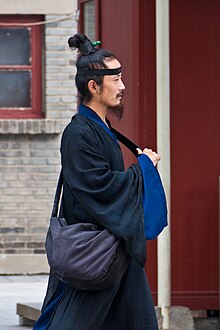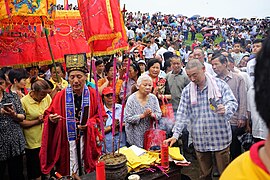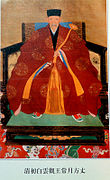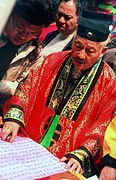Daopao
| Daopao | |||||||
|---|---|---|---|---|---|---|---|
 Daopao ( đạo bào )/ Xingyi ( hành y ) - formal wear for men | |||||||
| Chinese name | |||||||
| Chinese | Đạo bào | ||||||
| Literal meaning | Taoist robe | ||||||
| |||||||
| Korean name | |||||||
| Hangul | 도포 | ||||||
| Hanja | Đạo bào | ||||||
| Literal meaning | Taoist robe | ||||||
| |||||||
| English name | |||||||
| English | Taoist robe | ||||||
Daopao(Chinese:Đạo bào;pinyin:dàopáo;lit.'Taoist robe'), also known asxuezi(Chinese:Điệp tử) when used as aXifuduringChinese operaperformances,[1][2]: 181 anddeluo(Chinese:Đắc la) when it is blue in colour,[3]is a traditional form ofpaofuinHanfuand is also one of the most distinctive form of traditional clothing for the Han Chinese.[4]Thedaopaowas one of the most common traditional form of outerrobeworn by men.[5]Daopaoliterally means "Taoist robe";[6][7]however, despite its name, thedaopaowere and is worn by men, and did not imply that its wearer had some affiliation totaoism.[5]Thedaopaocan be dated back to at least theMing dynasty[5]but had actually been worn since theSong dynasty.[citation needed]Initially the daopao was a form of casual clothing which was worn by the middle or lower class in the Ming dynasty.[1]In the middle and late Ming, it was one of the most common form of robes worn by men as casual clothing.[4]Thedaopaowas also a popular formal wear by theMing dynastyscholars in their daily lives.[2]: 77 It was also the daily clothing for the literati scholars in the Ming dynasty.[2]: 181 In the late Ming, it was also a popular form of clothing among the external officials and eunuchs sometimes wore it.[8]Thedaopaowas also introduced in Korea during theJoseonperiod, where it became known asdopoand was eventually localized in its current form.[9]
Thedaopaocan also refer to a type ofDaojiao fushi,which were worn by practitioners of taoism, when the term is used in its literal form.[10]: xvii This form ofdaopaoworn taoist practitioners and taoist monks continued to be worn in theQing dynastyas they were exempted from theTifayifupolicy.[2]: 181 Thedaopaoof the Taoist also continue to be worn by modern taoist priests, although it may come in different names.
DaopaoinHanfu[edit]
History and origins[edit]
Some sources posit that a form ofdaopaowithout a cord had evolved from thekuzhe,which refers to the military-style garments which had supposedly been influenced by the northern nomad warriors from the north in the past.[11]According toAntonia Finnanewho noted theGubu gulu《 cô bất cô lục 》of Wang Shizhen (1526-1590), the three robes which evolved from thekuzhe-style was theyesa,thechengziyi( trình tử y ) worn with a chord around the waist, and thedaopaoworn without chord.[11]: 45 [12]Theyesaof this period was a type of new garment which only appeared in the Ming dynasty and was likely localized from and developed under the influence of thejisünthe Yuan dynasty.[13][14]Thechengziyiwas developed in the late Ming and bore some similarities with theyesa.[15]In the same ancient text, Wang Shizhen also noted that thedaopaowas also calledzhiduo.[12]However, thezhiduowas another kind ofpaofuwhich had predated theYuan dynastyand can be traced back to theTang dynasty.[16][17]
Other Chinese sources also indicate that thedaopaohad been worn since theSong dynasty(960–1279).[citation needed]After the year 960 AD, the belteddaopaowas worn by the Taoist priests in order to distinguish themselves from others.[18]The broad and elegant robes which were initially worn byTaoist priestswere known as thedaofu(Chinese:Đạo phục;pinyin:dàofú;lit.'Taoist clothing'; sometimes translated as "Taoist priest robe" ).[19]: 21
Song dynasty[edit]
In the Northern Song dynasty,Taoismwas highly revered.[20]: 94 During this period, thedaofualso became very popular and was greatly appreciated by some hermits and scholars during the Song dynasty and was mentioned in some poems written byWang YuchengandFan Zhongyan.[19]: 21 Some scholars, such Shi Manqing (994 –1041), who was a celebrated scholar in the Northern Song dynasty, would often wore adaofuwith a scarf worn in a free style.[19]: 21 The Shi Manqin-styledaofuwas liked by some officials who were in their retirement; and therefore, they dressed in this form ofdaofu.[19]: 21
In the Southern Song dynasty, it wasNeo-Confucianismwhich arose and flourished; a new form ofdaofubecame fashionable; this form ofdaofuwas the garment worn by the scholars which followed theDaoxue(Đạo học) Confucianism.[19]: 22 In the bookRules of Moral Teaching studybyZhu Xi,Zhu Xi stressed on the importance of dress code as being the first step for a person to be a "decent person".[19]: 5 Since Zhu Xi put so much emphasis on the dress code, the literati eventually gradually developed their own dressing style as an accepted custom, which included thedaofuwhich was worn as a form of leisure clothing.[19]: 5 Contemporary observers living in the Southern Song dynasty, such asShi Shengzu(1192-1274), also noted that the return of theclassic-style apparel in the Song dynasty had made thedaofupopular.[19]: 22 In Volume 2 of the chapterXuezhai zhanbi《Học trai chiêm tất》in theYinshi yifu jinjiebiangu《Ẩm thực y phục kim giai biến cổ》, Shi Shengzu reported that thedaofuhad been made popular by the use ofguanand the shoes calledlü;he associated the reason behind the popularity ofdaofuwith the attire style of the Taoist priests, which he observed, had remained unchanged for centuries.[19]: 22 He also concluded that the apparel system of the three ancient Chinese dynasties, referred collectively as theSandai(Tam đại), could still be found among the attire-style of the Taoist priests.[19]: 22
Ming dynasty[edit]
During theMing dynasty,the traditional clothing system of the Han Chinese, theHanfu,was restored following the fall of the Mongol-ledYuan dynasty.[4]Thedaofuand thedaopaocontinued to be worn in the Ming dynasty; thedaopaowas similar to thedaofuin the Ming dynasty, with the presence of decorative border trims on thedaofuas an exception.[21]However, despite the restoration of theHanfu-system by the Ming dynasty court, the shape of some garment, including thedaopao,had some differences from the ones worn in the Tang and Song dynasties as the clothing in the Ming dynasty had undergone a series of adjustments to their shapes.[4]The shape of the Ming dynastydaopao,and its colours, was strictly regulated by the political systems, rules and regulations of the time.[4]
Construction and design[edit]
Ming dynastydaopao[edit]

The Ming dynastydaopaois a full-length. It has a large frontal outer placket and smaller frontal inner placket. There is a pair of ties at the small placket and two pairs of ties on the large placket which is used for closing the garment.[4]The sleeves are large but are narrower around the wrists.[4]It characterized by a cross collar, which closes at the right side in the front, in a style calledjiaoling youren.[4]

It is also not completely stitched at the two sides and allows for side slits to begin below the waist level.[5][4]At the sides of the robes, there are side panels in the form of concealed swing or pendulum structure (i.e. a front and back swings at each sides of the robe).[4]These side panels at these slits, are calledanbai(Chinese:Ám bãi;pinyin:ànbǎi), and they were designed to conceal undergarments.

The neckline of the robe is often decorated with white or plain collars.[4]The collar can be either the same or a different colour to the main pieces of fabric. However, the collar is generally the same colour as the hems. An optional additional protective collar calledhuling(simplified Chinese:Hộ lĩnh;traditional Chinese:Hộ lĩnh;pinyin:hù lǐng;lit.'protective collar') could also be sewn to the first collar. Thehulingeither be white or dark in colour.[citation needed]
A belt calleddadai(simplified Chinese:Đại đái;traditional Chinese:Đại đái;pinyin:dàdài;lit.'large belt') was also fastened around the waist. In total, the structure of the Ming dynastydaopaowas made up of 10 parts.[4]

Ming dynastydaofu[edit]
In theMing dynasty,thedaofuwas a wide-sleeved, crossed-collar robe which closes to the right in a style calledjiaoling youren;it also had dark edging at the edges of the collar, sleeves, and placket.[21]In the collar edge, thehulingwas sometimes inserted.[21]The Ming dynastydaofuwas similar to thedaopao,except for the addition of edges decoration on the robe.[21]Belts, like thedadai(simplified Chinese:Đại đái;traditional Chinese:Đại đái) and thesitao(simplified Chinese:Ti thao;traditional Chinese:Ti thao;pinyin:sītāo;lit.'silk waistband'; i.e. a ribbon or a thin rope made of silk) was also used around the waist when wearing thedaofu.[21]
Derivatives and influences[edit]
China[edit]
Xuezi[edit]

Thexuezi(Chinese:Điệp tử) which is a costume inXifu,is a derivative of the Ming dynastydaopaowhich was worn by the Ming dynasty scholars as an every day formal attire.[2]: 77, 181 It is also a derivative of thejiaolingpaowhich dates back from theZhou dynasty.[22]: 54
In theQing dynasty,actors who performed inChinese operaperformance were allowed to wearHanfuandHanfu-styleXifuas they were exempted from theTifayifupolicy.[23]Therefore, thexueziwas therefore allowed to be worn and continues to be worn even in present days, where it is now one of the most common form of costumes worn on stage.[2]: 77, 181
When used in Chinese opera, thexueziis a form of informal dress worn by performers who hold theshengrole types, which include thexiaosheng[22]: 31–32 and thewenxiaosheng.[22]: 3 Performers playing female roles could also wear axuezicallednüxuezi,which was also used as an informal robe.[22]: 54
Construction and design[edit]
Thexueziis structurally different from thejiaolingpao:thexuezihas a trapezoid body, narrower sleeves which is tubular in shape, the sleeves are longer than the wrists, andwater sleevesare also added; there is an asymmetrical closure where the right side is right below the shoulder and neck intersection while the left crossing over is tied right under the right arm in a style calledjiaoling youren.[22]: 54 There are also differences in the shapes and forms of thexuezidepending on the role types:
Actors performing the role of men wear a full-lengthxueziwhile actors performing the role of women wear a knee-lengthxuezi;the malexuezihas ajiaoling yourenclosure while there are two types of closure for thenüxuezi,one which has ajiaoling yourenclosure and one which has front central closure,[22]: 54, 276–294 a style which can be referred asduijin.
Thewenxiaoshengoften wearsxueziof pastel colours, which is embroidered with flowers and haswater sleeves.[22]: 3, 6
Korea[edit]
Thedaopaowas imported from theMing dynastyto Korea during theJoseonperiod, where it became known asdopoand was eventually localized in Korea gaining its current form.[9]In this period, the intellectual current which had been popularized in Joseon was theZhuzi studies(viz.Trình chu lý học:Trình tử lý họcandChu tử lý học) which was of Chinese origins.[24]According to the Joseon literati, Sŏng Tae-chung, who visitedJapanin the 1764 at a time when the Ming dynasty had already fallen, when asked what he wore as a robe and headwear by Ryūzan, Sŏng Tae-chung answered that he was wearing thedopoand thebokgeonwhich were the attire of the ancient sages 《 quan phúc cân y đạo bào, nãi cổ thánh hiền sở trứ 》; thedopoandbokgeonwere both Confucian attire and dressing style which had been adopted in Joseon.[24]
Daojiao Fushi[edit]

The traditional clothing worn by the Taoist community is connected to pre-modern Chinese clothing and styles.[25]Tradition-based taoists will often wear the traditional robes and liturgical clothing for formal religious and ritual occasions whileZhengyipriests and taoists priests outside mainland China tend to wearWestern clothingin their daily lives.[25]The traditional taoist robes can also be worn as a daily lives clothing by theQuanzhenmonastics in mainland China.[25]There were many forms of daojiao fushi in the ancient China.
Daopao/ hechang[edit]
Some forms of taoist robes are also referred ascrane robes(hechang, hạc sưởng ).[26]The Taoist priests' daopao which date back to at least the 1800s is not cross collared and instead looks like abeiziin terms of construction and design; a clothing artefact showing this style of daopao is now stored in museums such as theRhode Island School of Design Museum.[27]The Taoist's priest daopao are commonly worn by the Taoism priests.[6]It is worn by middle-ranks Taoist priests; it is red in colour and has motifs at the back and front, on the sleeves.[27][28]Theses motifs decorations can include, thebaguaand cranes.[28]
-
A taoist priest wearing a modern-day taoist's daopao (depicted as a red overcoat), 2017.
-
Wang Changyue, Qing dynasty.
-
Taoist Priest in Macau, 2006.
Jiangyi[edit]
Jiangyi (Chinese:Thao y;pinyin:jiàngyī), also known as "robe of descent" which refers to either the descent of a priest from the altar or of the spirits to the altar, is a common form of Taoist priest's clothing.[6]The jiangyi is a sign of the higher priestly rank and is worn by grandmasters.[6][27]It was worn at least since the Ming and Qing dynasties.[29]
It looks similar to aponchoin structure;[6]when worn, the robe sits squarely on the shoulders of the Taoist' priest; it is usually fastened across the front with two silk ties which are sewn just above the waist level.[30]It is made of embroidered silks and is composed of a large square of satin fabric folded into two to form the shoulder line; the shoulder lines continues to the hem of the sleeves.[30]The robe is slashed in the middle to form the collar of the robe.[30]It is typically trimmed with border decorations.[30]
-
Zhengyi taoist priest wearing jiangyi, Ming dynasty.
-
Daoist priest's robe (jiangyi), China, Qing dynasty, late 18th to early 19th century AD/
-
Daoist Priest's Robe (jiangyi), 19th century
-
Daoist Priest's Robe (jiangyi), late 18th–early 19th century
-
Daoist priest's robe (jiangyi), China, 20th century.


Daoyi[edit]
TheQuanzhenmonastic taoist priests and nuns wear a wide-sleeved, cross-collared gown calleddaoyi( đạo y; lit. "robe of the Dao" ) which closes to the right; it is a standard type of clothing.[25]The sleeves of the daoyi is referred as "cloud sleeves"; they are wide, open at the ends, and their sleeves are so long that it is past the fingers when extended but can be even longer.[25]In the Quanzhen order, the dagua is worn as one of the ordinary clothing while the deluo is a formal clothing.[28]
Deluo[edit]

Thedeluo( đắc la ) is a cross-collared gown with large sleeves.[31]It is worn by Taoist priests of theQuanzhen orderis a formal ritual dress which is indigo in colour.[28]The blue colour is a symbolism for the east and represents having been descended from the first patriarch of theQuanzhen school,Donghua dijun.[28]In large temples (e.g. Baiyunguan in Beijing), the deluo would be worn by monastics on festival days; the deluo would have wide sleeves which could reach 45 cm.[7]
Daogua[edit]
In the Wengong temple inHanzhong,the cross-collar daopao is the standard form of attire and is referred asdaogua(Chinese:Đạo quái;lit.'Taoist robe or jacket' depending on context).[7]Their daopao is cross-collared at the front, and the sleeves are so long that only the fingers can escape from the sleeves.[7]It is made of thick garments and is blue or black in colour.[7]The daogua can be found in 3 types: dagua (Chinese:Đại quái;lit.'great gown'; a long cross-collar robe which reaches the ankles and has a 42 cm wide sleeves), zhonggua ( trung quái; a cross-collar robe which reaches the mid-calf and has slightly narrower sleeves than the dagua), and xiaogua ( tiểu quái; a cross-collar robe which reaches the hip and has sleeves which could either be the same size or narrower than a zhongua; the xiaogua is more similar to a jacket than a robe).[7]
Similar garments[edit]
- Sengyi ( tăng y ) - Long buddhist robesabbot.
- Hai Qing ( hải thanh ) - Buddhist ritual garment.
- Zhiduo,also known as zhishen ( trực thân ) - a style similar to the daopao except that it was decorated with outside pendulums.[8]
- Dopo (clothing)- A Korean equivalent
See also[edit]
References[edit]
- ^abYe, Tan (2020).Historical dictionary of Chinese theater(Second ed.). Lanham. p. 48.ISBN978-1-5381-2064-4.OCLC1128888776.
{{cite book}}:CS1 maint: location missing publisher (link) - ^abcdefWang, Guojun (2020).Staging personhood: costuming in early Qing drama.New York.ISBN978-0-231-54957-8.OCLC1129398697.
{{cite book}}:CS1 maint: location missing publisher (link) - ^Pi lu si bi hua.Dianfeng Kang, khang điện phong. (Di 1 ban ed.). Shijiazhuang Shi: Hebei mei shu chu ban she. 1998. p. 244.ISBN7-5310-1111-5.OCLC43293523.
{{cite book}}:CS1 maint: others (link) - ^abcdefghijklSong, Ma; yue, Li; xiaogang, Wang (2021-07-01)."Research on the Ming Dynasty Dao Robe Modeling Method Based on 3D Simulation Technology".Journal of Physics: Conference Series.1965(1): 012040.Bibcode:2021JPhCS1965a2040S.doi:10.1088/1742-6596/1965/1/012040.ISSN1742-6588.
- ^abcdGwynne, Paul (2017).World religions in practice: a comparative introduction(Second ed.). Hoboken, NJ. p. 222.ISBN978-1-118-97227-4.OCLC972639879.
{{cite book}}:CS1 maint: location missing publisher (link) - ^abcde"From the Land of the Immortals | RISD Museum".risdmuseum.org.Retrieved2022-05-14.
- ^abcdefHerrou, Adeline (2016).A World of Their Own: Daoist Monks and Their Community in Contemporary China.St Petersburg: Three Pines Press. pp. 43–45.ISBN978-1-365-53752-3.OCLC1011219060.
- ^abYuan, Zujie (2007)."Dressing for power: Rite, costume, and state authority in Ming Dynasty China".Frontiers of History in China.2(2): 181–212.doi:10.1007/s11462-007-0012-x.ISSN1673-3401.S2CID195069294.
- ^ab"A Study on the Origin and Structural Development of Do-po".Journal of the Korean Society of Costume.36:1–23. 1998.ISSN1229-6880.
- ^Wang, Richard G. (2012).The Ming prince and Daoism: institutional patronage of an elite.New York: Oxford University Press.ISBN978-0-19-990989-6.OCLC796803927.
- ^abAntonia Finnane (2007).Changing clothes in China: fashion, history, nation.Columbia University Press.pp. 44–45.ISBN978-0-231-14350-9.
- ^abWang, Zhishen."Gubu Gulu"Cô bất cô lục.zh.wikisource.org(in Simplified Chinese).Retrieved2022-06-25.
- ^Wei, Luo (2018-01-02)."A Preliminary Study of Mongol Costumes in the Ming Dynasty".Social Sciences in China.39(1): 165–185.doi:10.1080/02529203.2018.1414417.ISSN0252-9203.S2CID149138176.
- ^Wang, Chen (2014-09-01)."Conservation study of Ming dynasty silk costumes excavated in Jiangsu region, China".Studies in Conservation.59(sup1): S177–S180.doi:10.1179/204705814X13975704319154.ISSN0039-3630.S2CID191384101.
- ^Li, Laiyu (2017)."Mingdai nanzi fushi——yunxiang yishang xilie"Minh đại nam tử phục sức —— vân tưởng y thường hệ liệt[Men's Clothing in Ming Dynasty - Yunxiang Clothing Series].www.kaogu.cn(in Chinese).Retrieved2022-06-25.
- ^Cheng, Fung Kei (2020-07-28)."Intertwined Immersion: The Development of Chinese Buddhist Master Costumes as an Example".Religious Studies.8(1): 23–44.ISSN0536-2326.
- ^Yifa (2002).The origins of Buddhist monastic codes in China: an annotated translation and study of the Chanyuan qinggui.Zongze. Honolulu: University of Hawaii Press. p. 252.ISBN0-585-46406-5.OCLC52763904.
- ^Snodgrass, Mary Ellen (2015).World Clothing and Fashion: an Encyclopedia of History, Culture, and Social Influence.Hoboken: Taylor and Francis. p. 488.ISBN978-1-317-45167-9.OCLC910448387.
- ^abcdefghijZhu, Ruixi; chu thụy hi (2016).A social history of middle-period China: the Song, Liao, Western Xia and Jin dynasties.Bangwei Zhang, Fusheng Liu, Chongbang Cai, Zengyu Wang, Peter Ditmanson, Bang Qian Zhu (Updated ed.). Cambridge, United Kingdom.ISBN978-1-107-16786-5.OCLC953576345.
{{cite book}}:CS1 maint: location missing publisher (link) - ^Chengyu, Fang, Alex (2016).The Language and Iconography of Chinese Charms Deciphering a Past Belief System.Springer Singapore, Imprint: Springer.ISBN978-981-10-1793-3.OCLC1050008489.
{{cite book}}:CS1 maint: multiple names: authors list (link) - ^abcde"Chinese Traditional Costume - Ming Style Daofu for Male".www.newhanfu.com.22 October 2020.Retrieved2021-08-14.
- ^abcdefgBonds, Alexandra B. (2008).Beijing opera costumes: the visual communication of character and culture.Honolulu: University of Hawaiʻi Press.ISBN978-1-4356-6584-2.OCLC256864936.
- ^Su, Wenhao (2019)."Study on the Inheritance and Cultural Creation of Manchu Qipao Culture".Proceedings of the 3rd International Conference on Art Studies: Science, Experience, Education (ICASSEE 2019).Vol. 368. Atlantis Press. pp. 208–211.doi:10.2991/icassee-19.2019.41.ISBN978-94-6252-837-6.S2CID213865603.
{{cite book}}:|journal=ignored (help) - ^abLi., David C. S. (2022).Brush Conversation in the Sinographic Cosmopolis Interactional Cross-border Communication Using Literary Sinitic in Early Modern East Asia.David Li; Reijiro Aoyama; Tak-sum Wong. Taylor & Francis.ISBN9781000579871.OCLC1303084702.
- ^abcdeKomjathy, Louis (2013).The Daoist tradition: an introduction.London. p. 290.ISBN978-1-4411-1669-7.OCLC819275585.
{{cite book}}:CS1 maint: location missing publisher (link) - ^Zhuo, Xinping (2018).Religious faith of the Chinese.Singapore. p. 44.ISBN978-981-10-6379-4.OCLC1017489156.
{{cite book}}:CS1 maint: location missing publisher (link) - ^abc"Daopao (Taoist priest's robe) | RISD Museum".risdmuseum.org.Retrieved2021-04-05.
- ^abcdeThe encyclopedia of taoism.Fabrizio Pregadio. Richmond: Curzon. 2002. p. 457.ISBN978-1-135-79634-1.OCLC810277082.
{{cite book}}:CS1 maint: others (link) - ^"Daoist Robe, 17th century, China".www.metmuseum.org.Retrieved2022-05-14.
- ^abcd"Daoist Robe".Victoria and Albert Museum: Explore the Collections.Retrieved2022-05-14.
- ^"What is Taoist Clothing? - 2021".www.newhanfu.com.2020.Archivedfrom the original on 2021-01-25.Retrieved2021-04-05.










